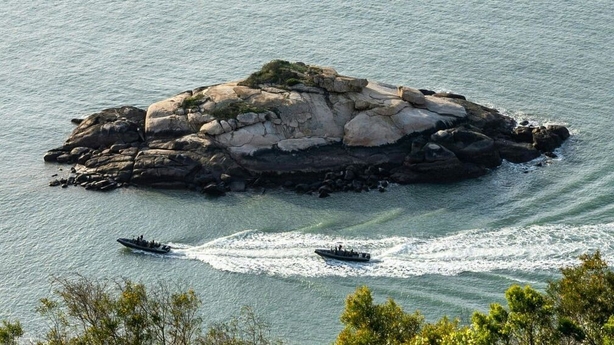China has ended three days of military drills around Taiwan saying it had tested integrated military capabilities under actual combat conditions, having practised precision strikes and blockading the island that Beijing views as its own.
China announced the drills on Saturday, after Taiwan's President Tsai Ing-wen returned to Taipei following a meeting in Los Angeles with US House of Representatives Speaker Kevin McCarthy.
China has never renounced the use of force to bring the democratically-governed island under Beijing's control.
Taiwan's government strongly disputes China's claims and has denounced the drills.
The Chinese military said it had "successfully completed" the exercises and "comprehensively tested" the capabilities of multiple units under actual combat conditions.
"The troops in the theatre are ready to fight all the time and can fight at any time, resolutely crushing any form of Taiwan independence separatism and foreign interference," the Eastern Theatre Command of the People's Liberation Army said in a statement.
Chinese state television said earlier that aircraft, including nuclear-capable H-6 bombers armed with live missiles, and warships staged drills to "form a multi-directional island-encompassing blockade situation".
The Eastern Theatre Command said the Shandong aircraft carrier had also taken part in combat patrols, and it showed fighters taking off from its deck.
Taiwan has been tracking the Shandong since last week in the Pacific Ocean.
Taiwan's defence ministry published a map of the previous 24 hours of Chinese air force activities, showing four carrier-based Chinese J-15 fighters operating over the Pacific Ocean to Taiwan's east.
The ministry said that as of this morning it had spotted 59 military aircraft and 11 ships around Taiwan, and that the Shandong carrier group was conducting drills in the Western Pacific.

The Shandong conducted air operations in waters close to Japan's Okinawan islands on Sunday, Japan's defence ministry said.
Jet fighters and helicopters took off and landed on the carrier 120 times between Friday and yesterday, with the carrier, three other warships and a support vessel coming within 230km of Japan's Miyako island, the defence ministry said.
The United States, which had repeatedly called for China to show restraint, sent the USS Milius guided-missile destroyer through contested parts of the South China Sea.
"This freedom of navigation operation upheld the rights, freedoms, and lawful uses of the sea," the US Navy said in a statement.
It added that the vessel had passed near the Spratly Islands - an archipelago claimed by China, Taiwan, the Philippines, Vietnam, Malaysia and Brunei. It is about 1,300km from Taiwan.
The deployment of the Milius immediately triggered more anger from China, which said the vessel had "illegally intruded" into its territorial waters.
Japan has been following China's military drills around Taiwan "with great interest", a government spokesperson said.
Japan has long worried about China's military activities in the area given how close southern Japanese islands are to Taiwan.
The southern Japanese island of Okinawa hosts a major US air force base, and last August when China staged war games to protest the visit of then-US House Speaker Nancy Pelosi to Taipei, Chinese missiles landed within Japan's exclusive economic zone.
The European Union also expressed concern, saying Taiwan's status should not be changed by force as any escalation, accident or use of force there would have huge global implications.
Read more:
China's drills around Taiwan: Key questions
The Taiwan Strait - A history of crises
China's military simulated precision strikes against Taiwan in the second day of drills around the island yesterday.
The Eastern Theatre Command released a short video on its WeChat account showing an H-6 bomber flying in what it said was the skies north of Taiwan.
"The missiles are in good condition," an unidentified voice says, as the video portrays images from the cockpit.
"Start the fire control radar, lock on the target," another voice says, showing images of a missile under the aircraft's wing.
A pilot is then seen readying the fire control button for what it describes as a simulated attack, and pressing the button, though it did not show any missiles being fired.
Taiwan's military has repeatedly said it will respond calmly to China's drills and not provoke conflict.
The defence ministry separately released pictures of mobile launchers for the Taiwan-made Hsiung Feng anti-ship missiles at an undisclosed location, as well as missile-armed fast attack boats at sea.
Reporters at the Cape Maobitou park in Pingtung county on Taiwan's southern tip saw Hsiung Feng launchers deployed near a scenic spot on Monday, as soldiers stood guard and tourists watched and posed for pictures.
Life in Taiwan has continued normally with no signs of panic or disruption, and civilian flights operating as usual.
"Most normal people probably aren't afraid, with the main reason being that everyone thinks that China will certainly not start a war," said 78-year-old Tang Pao-hsiung, a former soldier.

